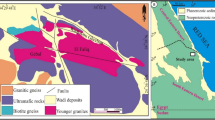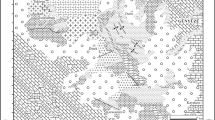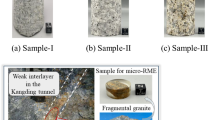Abstract
The effect of alteration on the geochemistry and mechanical properties of granite from Pingjiang, Hunan Province, China was investigated. Six weathered and 14 hydrothermally altered samples in 3 adits were collected for mechanical strength tests, mineralogical and geochemical analysis. The types of alteration observed within the samples were chloritization and argillization. Samples taken from a silicified fracture zone were enriched in quartz. Weathering was observed to significantly weaken the granite whereas the effects of hydrothermal alteration on strength were more complex. The porosity increased with the enrichment of the altered minerals, indicating that the formation of altered minerals degrades the strength of physical bonds between minerals within the granite. The granite Na2O, CaO, K2O, MgO and SiO2 contents decreased while Fe2O3T increased due to weathering. Variations of major elements within the hydrothermally altered granite were distinguished from those observed in weathered samples—notably Mg was removed whilst Si and Fe were generally stable during the hydrothermal alteration. Whereas the quartz-enriched samples gained Si with slight depletions in Mg and Fe. Trace and rare earth elements were both removed in hydrothermal alteration. The variable behavior of major element was quantified by the mobility index which indicated that the different geochemical changes were attributed tochloritization and argillization. Furthermore, the mobility index of Mg was used to identify the dominated alteration in granite and evaluate the effects of chloritization and argillization. Generally, chloritization was found to be more dominant than argillization in weakening the granite.

modified from Xu et al. 2009)

modified from Xu et al. 2009)






Similar content being viewed by others
References
Aiuppa A, Allard P, D’Alessandro W, Michel A, Parello F, Treuil M, Valenza M (2000) Mobility and fluxes of major, minor, and trace metals during basalt weathering and groundwater transport at Mt. Etna volcano (Sicily). Geochim Cosmochim Acta 64:1827–1841
Alderton DHM, Pearce JA, Potts PJ (1980) Rare earth element mobility during granite alteration: evidence from southwest England. Earth Planet Sci Lett 49:149–165
Arıkan F, Ulusay R, Aydın N (2007) Characterization of weathered acidic volcanic rocks and a weathering classification based on a rating system. Bull Eng Geol Environ 66:415–430
Baker JH (1985) Rare earth and other trace element mobility accompanying albitization in a Proterozoic granite, W. Bergslagen, Sweden. Mineral Mag 49:107–115
Baud P, Wong T, Zhu W (2014) Effects of porosity and crack density on the compressive strength of rocks. Int J Rock Mech Min Sci 67:202–211
Brown ET (1981) Rock characterisation, testing and monitoring, ISRM suggested methods. International Society for Rock Mechanics, Pergamon
Browne PRL (1978) Hydrothermal alteration in active geothermal fields. Annu Rev Earth Planet Sci 6:229–250
Ceryan S, Tudes S, Ceryan N (2008) Influence of weathering on the engineering properties of Harsit granitic rocks (NE Turkey). Bull Eng Geol Environ 67:97–104
Chen D (1999) Engineering geological problems in the Three Gorges Project on the Yangtze, China. Eng Geol 51:1–11
Chen X, He P, Qin Z (2018) Damage to the microstructure and strength of altered granite under wet–dry cycles. Symmetry 10:716
Chigira M, Nakamoto M, Nakata E (2002) Weathering mechanisms and their effects on the landsliding of ignimbrite subject to vapor-phase crystallization in the Shirakawa pyroclastic f low, northern Japan. Eng Geol 66:111–125
Coggan JS, Stead D, Howe JH, Faulks CI (2013) Mineralogical controls on the engineering behavior of hydrothermally altered granites under uniaxial compression. Eng Geol 160:89–102
Columbu S, Gioncada A, Lezzerini M, Sitzia F (2019) Mineralogical-chemical alteration and origin of ignimbritic stones used in the old Cathedral of Nostra Signora di Castro (Sardinia, Italy). Stud Conserv 64:397–422
Columbu S, Palomba M, Sitzia F, Carcangiu G (2020) Pyroclastic stones as building materials in medieval romanesque architecture of Sardinia (Italy): chemical-physical features of rocks and associated alterations. Int J Arch Herit. https://doi.org/10.1080/15583058.2020.1749729
Dawood YH, Saleh GM, Abd El-Naby HH (2005) Effects of hydrothermal alteration on geochemical characteristics of the El Sukkari granite, central Eastern Desert, Egypt. Int Geol Rev 47:1316–1329
Del Potro R, Hürlimann M (2009) The decrease in the shear strength of volcanic materials with argillic hydrothermal alteration, insights from the summit region of Teide stratovolcano, Tenerife. Eng Geol 104:135–143
Duzgoren-Aydin NS, Aydin A, Malpas J (2002) Re-assessment of chemical weathering indices: case study on pyroclastic rocks of Hong Kong. Eng Geol 63:99–119
Farmer GL, DePaolo DJ (1987) Nd and Sr isotope study of hydrothermally altered granite at San Manuel, Arizona; implications for element migration paths during the formation of porphyry copper ore deposits. Econ Geol 82:1142–1151
Fritz SJ, Mohr DW (1984) Chemical alteration in the micro weathering environment within a spheroidally-weathered anorthosite boulder. Geochim Cosmochim Acta 48:2527–2535
Frolova YV, Ladygin VM, Rychagov SN (2012) Patterns in the transformation of the composition and properties of volcanogenic rocks in hydrothermal-magmatic systems of the Kuril-Kamchatka island arc. Mosc Univ Geol Bull 66:430–438
Guan P, Ng CWW, Sun M, Tang W (2001) Weathering indices for rhyolitic tuff and granite in Hong Kong. Eng Geol 59:147–159
Heap MJ, Xu T, Chen C (2014) The influence of porosity and vesicle size on the brittle strength of volcanic rocks and magma. Bull Volcanol 76:1–15
Helgeson HC (1970) Description and interpretation of phase relations in geochemical processes involving aqueous solutions. Am J Sci 268:415–438
Hemley JJ, Jones WR (1964) Chemical aspects of hydrothermal alteration with emphasis on hydrogen metasomatism. Econ Geol 59:538–569
Huang ZQ, Wang Z, Hou HM (2011) Alteration and engineering characteristics of altered-rock in Tianchi Pumped-storage power station. J North China Inst Water Conserv Hydroelectr Power 32:1–5 ((in Chinese with English abstract))
Huang JH (2017) Alteration mineral geochemistry of VMS deposit—case study of the Honghai Cu-Zn deposit, Eastern Tianshan, NW China. Dissertation, University of Chinese Academy of Sciences (in Chinese with English abstract)
Hurwitz S, Ingebritsen SE, Sorey ML (2002) Episodic thermal perturbations associated with groundwater flow: An example from Kilauea Volcano, Hawaii. J Geophys Res 107:1301–1310
Julia F, Vladimir L, Sergey R, David Z (2014) Effects of hydrothermal alterations on physical and mechanical properties of rocks in the Kuril-Kamchatka island arc. Eng Geol 183:1–16
Kahraman S, Gunaydin O, Fener M (2005) The effect of porosity on the relation between uniaxial compressive strength and point load index. Int J Rock Mech Min Sci 42:584–589
Lan HX, Hu RL, Yue ZQ, Lee CF, Wang SJ (2003) Engineering and geological characteristics of granite weathering profiles in South China. J Asian Earth Sci 21:353–364
Li L, Aubertin M (2003) A general relationship between porosity and uniaxial strength of engineering materials. Can J Civ Eng 30:644–658
Li XH, Li ZX, Wingate MTD, Chung SL, Liu Y, Lin GC, Li WX (2006) Geochemistry of the 755Ma Mundine Well dyke swarm, northwestern Australia: part of a Neoproterozoic mantle superplume beneath Rodinia? Precambr Res 146:1–15
Lv CX, Wu GG, Chen XL, Zhang YC, Zhang XY, Zhao H (2011) Structural and geochemical characteristics of alteration zone of Xincheng gold deposit. Geotecton Metallog 35:618–627 ((in Chinese with English abstract))
Ma TF (2014) Research on high strength concrete strength survey based on rebound method in Hebei. Dissertation, Hebei University of Technology (in Chinese with English abstract)
Ma L, Chen Q, Zhu J, Xi Y, He H, Zhu R, Ayoko GA (2016) Adsorption of phenol and Cu (II) onto cationic and zwitterionic surfactant modified montmorillonite in single and binary systems. Chem Eng J 283:880–888
Meller C, Kontny A, Kohl T (2014) Identification and characterization of hydrothermally altered zones in granite by combining synthetic clay content logs with magnetic mineralogical investigations of drilled rock cuttings. Geophys J Int 199:465–479
Miao C (2017) Study on influence of altered-rock to geological characteristics and its engineering—exemplified by Dagangshan Hydropower station. Dissertation, Chengdu University of Technology
Moon V, Jayawardane J (2004) Geomechanical and geochemical changes during early stages of weathering of Karamu Basalt, New Zealand. Eng Geol 74:57–72
Palchik V, Hatzor YH (2004) The influence of porosity on tensile and compressive strength of porous chalks. Rock Mech Rock Eng 37:331–341
Parry WT, Downey LM (1982) Geochemistry of hydrothermal chlorite replacing igneous biotite. Clays Clay Miner 30:81–90
Pola A, Crosta G, Fusi N, Barberini V, Norini G (2012) Influence of alteration on physical properties of volcanic rocks. Tectonophysics 566–567:67–86
Pola A, Crosta GB, Fusi N, Castellanza R (2014) General characterization of the mechanical behaviour of different volcanic rocks with respect to alteration. Eng Geol 169:1–13
Qin Z, Fu H, Chen X (2019) A study on altered granite meso-damage mechanisms due to water invasion-water loss cycles. Environ Earth Sci 78:1–10
Saar MO, Manga M (1999) Permeability-porosity relationship in vesicular basalts. Geophys Res Lett 26:111–114
Sharma A, Rajamani V (2000) Major element, REE, and other trace element behavior in amphibolite weathering under semiarid conditions in Southern India. J Geol 108:487–496
Shea T, Houghton BF, Gurioli L, Cashman KV, Hammer JE, Hobden BJ (2010) Textural studies of vesicles in volcanic rocks: an integrated methodology. J Volcanol Geoth Res 190:271–289
Sumner P, Nel W (2002) The effect of rock moisture on Schmidt hammer rebound: tests on rock samples from Marion Island and South Africa. Earth Surf Process Landf 27:1137–1142
Sun SS, McDonough WF (1989) Chemical and isotopic systematics of oceanic basalts: implications for mantle composition and processes. Geol Soc Lond Spec Publ 42:313–345
Ulusay R, Türeli K, Ider MH (1994) Prediction of engineering properties of a selected litharenite sandstone from its petrographic characteristics using correlation and multivariate statistical techniques. Eng Geol 38:135–157
Ündül Ö (2016) Assessment of mineralogical and petrographic factors affecting petro-physical properties, strength and cracking processes of volcanic rocks. Eng Geol 210:10–22
Wang AM, Zhou J, Zhong FW, Wu Q, Cui JL (2013) Characteristics analysis of rock weathering and alteration for Tianchi pumped storage power station. J North China Inst Water Conserv Hydroelectr Power 8:21–25 ((in Chinese with English abstract))
Wang AM, Li XG, Huang ZQ, Huang XC, Wang ZF, Wu Q, Cui JL, Lu XJ (2015) Laboratory study on engineering geological characteristics and formation mechanism of altered rocks of Henan Tianchi pumped storage power station, China. Environ Earth Sci 74:5063–5075
Watters RJ (2000) Rock mass strength assessment and significance to edifice stability, Mount Rainier and Mount Hood, Cascade Range Volcanoes. Pure Appl Geophys 157:957–976
Wyering LD, Villeneuve MC, Wallis IC, Siratovich PA, Kennedy BM, Gravley DM, Cant JL (2014) Mechanical and physical properties of hydrothermally altered rocks, Taupo Volcanic Zone, New Zealand. J Volcanol Geoth Res 288:76–93
Xu DR, Wang L, Li PC, Chen GH, He ZL, Fu GG, Wu J (2009) Petrogenesis of Lianyunshan granites in northeastern Hunan Province, South China, and its geodynamic implications. Acta Petrol Sin 25:1–23 ((in Chinese with English abstract))
Xu R, Romer RL, Glodny J (2020) External fluids cause alteration and metal redistribution in the granite-hosted Tangziwa SnCu deposit, Gejiu district, China. Lithos 2:2. https://doi.org/10.1016/j.lithos.2020.105937
Yang GL (2007) Altered-rock characteristics and its engineering respondences studying—exemplified by Xiaowan hydropower station, Lancang revier. Dissertation, Chengdu University of Technology
Yıldız A, Kuşcu M, Dumlupunar I, Arıtan AE, Bağcı M (2010) The determination of the mineralogical alteration index and the investigation of the efficiency of the hydrothermal alteration on physico-mechanical properties in volcanic rocks from Köprülü, Afyonkarahisar, West Turkey. Bull Eng Geol Environ 69:51–61
Zhang W (1991) Structural and geochemical features of the Changsha-Pingjiang fracture dynamic metamorphism zone in NE. Hunan Province, China. Geotectonica et Metallogenia, pp 100–109 (in Chinese with English abstract)
Acknowledgements
This study is financially supported by grants from a National Key R&D Program of China (Grant no. 2019YFC1509704), the Natural Science Foundation of China (Grant nos. 41803033, 41903034), Central Plains Science and Technology Innovation Leader Project (Grant no. 214200510030) and the Research Foundation of North China University of Water Resources and Electric Power (no. 20171003). We thank Shengping Qian, Guangqian Hu, Yezhi He, Shengling Sun for their assistance in laboratory analysis. The authors also thank two anonymous reviewers and handling editor, Prof. Olaf Kolditz. The authors have declared that no conflict of interest exists.
Funding
This study is financially supported by grants from a National Key R&D Program of China (Grant no. 2019YFC1509704), the Natural Science Foundation of China (Grant nos. 41803033, 41903034), Central Plains Science and Technology Innovation Leader Project (Grant no. 214200510030) and the Research Foundation of North China University of Water Resources and Electric Power (no. 20171003).
Author information
Authors and Affiliations
Corresponding authors
Additional information
Publisher's Note
Springer Nature remains neutral with regard to jurisdictional claims in published maps and institutional affiliations.
Rights and permissions
About this article
Cite this article
Ren, M., Wang, W., Huang, Z. et al. Effect of alteration on the geochemistry and mechanical properties of granite from Pingjiang, Hunan Province, China. Environ Earth Sci 81, 60 (2022). https://doi.org/10.1007/s12665-022-10197-z
Received:
Accepted:
Published:
DOI: https://doi.org/10.1007/s12665-022-10197-z




